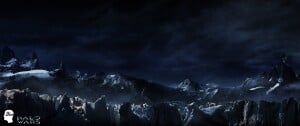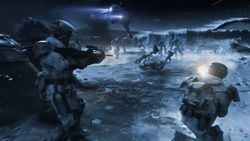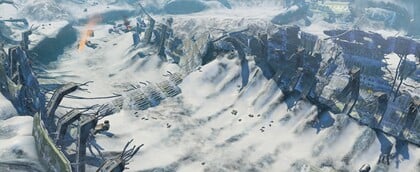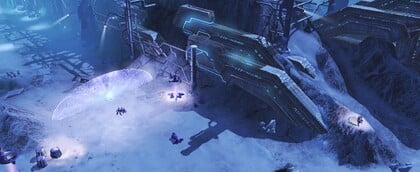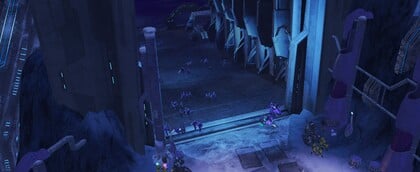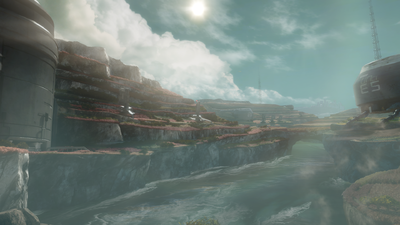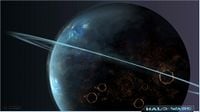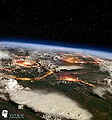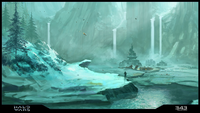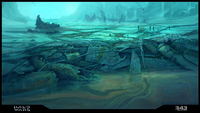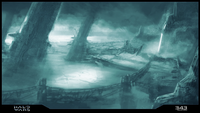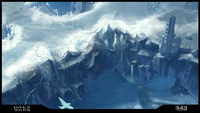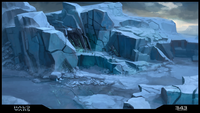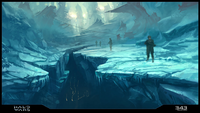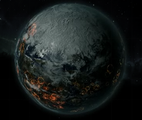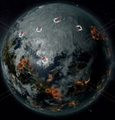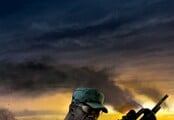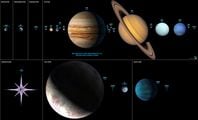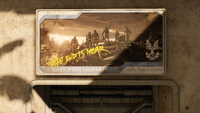Harvest
From Halopedia, the Halo wiki
| Harvest | |
|---|---|
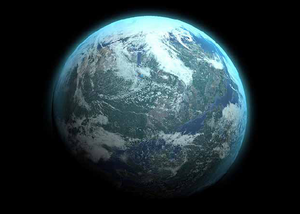
| |
| Astrographical | |
|
System: |
|
|
Orbiting: |
|
|
Orbital position: |
|
|
Moon(s): |
None[2] |
| Physical | |
|
Diameter: |
|
|
Gravity: |
|
|
Length of day: |
17.5 hours[2] |
|
Atmosphere: |
|
|
Surface temperature: |
|
| Societal | |
|
Species: |
|
|
Population: |
|
|
Colonized: |
|
|
Government: |
|
Harvest, also known as Epsilon Indi IV,[3] designated CE-309-8 d by the Forerunners,[2][4] was a human Outer Colony world founded as a "breadbasket" world. Founded in 2468 by the UNSC Skidbladnir, the colony was the most remote at the time of its founding.[5][Note 2] Located in the Epsilon Indi system,[6] the planet had the unfortunate distinction of being the first human planet discovered and destroyed by the Covenant. After a disastrous first contact, the planet was subsequently glassed by the Covenant, but most of its population managed to escape in freighters.[7]
Overview[edit]
Topography[edit]
Harvest was a small planet, approximately one-third the size of Earth with an equatorial diameter of slightly more than 4,000 kilometers (2,484 miles), making Harvest slightly smaller than the Sol planet Mercury.[8] In terms of surface area, Harvest possessed ~50 million km², roughly one-tenth the surface area of Earth. Harvest orbited Epsilon Indi extremely quickly, much faster than most other UNSC colonies, at roughly 150,000 km/h, or ~41 km/sec (by comparison, Earth orbits Sol at roughly 30 km/sec). Harvest had no natural satellites. Harvest also has a day/night cycle only 17.5 Earth hours long. Out of a total of five planets in the Epsilon Indi system, Harvest was the only habitable planet, as well as being fertile for farming. The super-continent Edda dominated the planet, taking up roughly 67% of its surface. Two low-salinity seas covered the remainder of the planet, Hugin to the north, and Munin to the south.[9] Almost 86% of Edda is within 500 meters of sea level, the only major change in elevation is the Bifrost, an escarpment that "cuts" Edda in half.
Harvest's surface was once beautiful, covered in grassland and forests, lush fields and rolling hills, and a thousand lakes swarming with fish. The orchards were filled with luscious crops. Starlings and bats were among the introduced species.[10]
After being glassed, however, the surface was reduced to a layer of melted glass, the destruction visible from orbit.[11] The environment suffered a catastrophic blow as a result, the once glorious landscape turning into a nearly frozen tundra, causing most species to quickly go extinct. Soon, all that remained of Harvest's original ecosystem were the scavengers, feeding off the rotting remains of the planet's once abundant wildlife, and even they perished before long. Now, the planet is submerged in nuclear winter, with no life on the surface. But, even after all of this, there are still several Forerunner complexes, surviving deep in the planet's mantle.[12] One species of bird was known to survive the glassing to 2531.[13]
Locations[edit]
- Edda
- Newton Armory
Known residents[edit]
- Orenski family
- April Orenski - Surviving cadet of Corbulo Academy of Military Science
- Wallace Jenkins - UNSC Marine Corps Private
- Nils Thune - Last Governor of the planet's government (Immigrated from Earth)
- Rol Pedersen - Last Attorney General of the planet's government
- Critchley - Colonial militiaman
- Gage Yevgenny - Orbital Drop Shock Trooper
- Dass - Colonial militiaman
History[edit]
Ancient history[edit]
Harvest was known to the Forerunners approximately 100,000 years prior to the Human-Covenant War. The planet was a relatively minor asset in the Forerunners' vast empire and was utilized as a conservation sphere waystation. The waystation facility included a subsidiary Flood research and containment center,[4] as well as administrative nodes that directed Forerunner defenses in the surrounding systems.[2] The structure housed a holographic stellar cartographer that pointed the way to another star system, Procyon.
Rise of humanity[edit]
Harvest was founded in 2468 when the UNSC Skidbladnir arrived transporting colonists, then dismantled to form the core of Utgard. One of the furthest and most isolated colonies to be founded by the UEG,[Note 2] the population was still small when Sergeant Avery J. Johnson engaged in his first mission on the planet. Harvest was settled by Lutheran Americans of Germanic descent.[14][15] Most locations on Harvest were named for elements of Norse mythology, as were its primary AIs, Sif and Loki/Mack. This is because many of Harvest's settlers were of Scandinavian ancestry.
By the time he returned in 2525, the population of Utgard alone had doubled.[citation needed]
Insurrection[edit]
In 2502, various secessionist and Insurrectionist groups were active on Harvest, including the People's Occupation Government, Harvest for Harvesters and the Secessionist Union, whose leader, Jerald Mulkey Ander, was assassinated by Avery Johnson as part of the ORION Project's Operation: KALEIDOSCOPE.[16]
Harvest was the first colony to be attacked by the Covenant and the first human world to be glassed. It was also the first place humanity officially made contact with the Covenant, after the incidents on This End Up and Minor Transgression.
In 2524, Staff Sergeant Johnson returned to Harvest along with Staff Sergeant Byrne and Captain Ponder, all survivors of Operation: TREBUCHET. They were to train a Colonial Militia and, unbeknownst to them, fend off what UNSC had believed to be Insurrectionist attacks on ships in the system.
On February 3, 2525, the Harvest orbital platform, the Tiara, made long-range radar and spectroscopic contact with Rapid Conversion. Contact with Harvest was lost thereafter.
Human-Covenant War[edit]
The citizens of Harvest soon found themselves in the middle of the first battle between the Covenant and humanity, using their newly trained Militia to herd hundreds of thousands of civilian survivors from Gladsheim, Vigrond and other locations to the Utgard space elevators to escape the planet.
First Battle of Harvest[edit]

- Main article: First Battle of Harvest
During the first Covenant attack on Harvest about 250,000+ humans managed to escape the planet by packing into 236 freight containers which were then loaded into seven elevator depots in Utgard. Every five to seven minutes, seven pairs of freight containers were loaded into the space elevator. Loaded ahead of these freight containers were seven "grease buckets", maintenance containers, two which were loaded with Johnson's men and Jilan al-Cygni. The other five were decoys rigged with claymore mines which were used to soften the Brutes, Grunts and Drones which had boarded and taken control of Tiara.[17] While the other two "grease buckets" holding Johnson and Co. stopped and they were fighting off the Covenant, the number seven strand of the space elevator snapped a few thousand kilometers above its anchor due to the stress caused by the load becoming unbalanced. There were 11 pairs of freight containers on the strand when it snapped, killing around 20,000 people.[18] The remaining freight containers carrying the survivors of Harvest continued up the elevator, out into space, where they met up with propulsion pods that Sif had placed previously. Once Johnson and Co. finished fighting the Covenant on the Tiara, they joined the survivors and used the propulsion pods to enter Slipspace.[19]
At the time of these occurrences, the first prototypes of the Brute Chopper was made by a Huragok named Lighter Than Some. However, these were destroyed by JOTUNs commanded by the AI Mack.
After the destruction of the Tiara, the now rampant AI Mack buried its strands in a form of a funerary ritual for the AI Sif.
The discovery of humans on Harvest was the catalyst for the attempted Covenant genocide of the human race, due to a mistranslation of the Forerunner glyph for "Reclaimer", for "Reclamation".
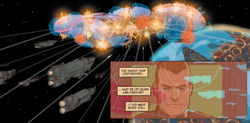
By April 20, the Colonial Military Authority sent the scout ship CMA Argo to investigate. Other then confirming its arrival at Epsilon Indi no other transmissions were sent, and the Argo was presumed MIA.
On October 7, Fleet Command assembled Battle Group 4 to investigate, due to the fact that the Harvest situation was deemed to have become serious. The battle group consisted of the destroyer CMA Heracles, commanded by Captain Veredi, as well as the frigates CMA Arabia and CMA Vostok. They entered the Harvest system only to find the planet's surface almost entirely melted down to glass. While there, the battle group encountered a Rasus-pattern interdictor. This vessel immediately fired on the inferior human vessels, and the Vostok and Arabia were lost with all hands. The Heracles managed to jump out of the system, but took several weeks to return to Reach due to damage sustained in the battle. Upon hearing Veredi's report and realizing the scale of the threat, the UNSC was placed on full alert and a fleet was assembled to meet the threat.[20]
Harvest campaign[edit]
Vice Admiral Preston J. Cole fought and barely won the Battle of Harvest in 2526. The UNSC was able to retake the planet but with the loss of 2/3 of their fleet, even when they had outnumbered the single Covenant ship in Harvest orbit.[21] Harvest would continue to be contested in the following years, as not long after, the Covenant attacked again. The battle for control of the planet lasted for five years until 2531, when Admiral Cole led a group of ships, including the UNSC Spirit of Fire into the system and neutralized the Covenant force. They later discovered that the Covenant had established a presence on the planet's surface, and more shockingly, had uncovered the previously unknown Forerunner relic which lead the Spirit of Fire to Arcadia,[22] where the Covenant then led them to a shield world where they were able to stop a major Covenant threat.
Ultimately, the Covenant once again returned to Harvest in 2534, glassing the planetary surface for a second and decisively final time.[23] After this event, Harvest was effectively abandoned by humanity.
Post-War[edit]
In the post-war era, Harvest has yet to see any formal effort at reclamation or rehabitation by humanity, due in part to sorrow at the conflict which consumed the world and impracticality due to the planet's location in deep-space.[24] Software simulations of Harvest's space elevator base have been created by the UNSC for use in their War Games training exercises, with Map_Set/: 309-8 used by Spartan Operations for such purposes.[25][26][2]
Government and society[edit]
Harvest was one of the Unified Earth Government's more productive and peaceful colonies.
The senior government official on Harvest was the Governor. The position was held by Nils Thune at the time of the planet's fall.[27] The Parliament of Harvest was also involved in the planet's governance. It met in a Parliament Building in Utgard.[28] One of its positions was the Attorney General, which was held by Rol Pedersen when the planet fell.
By 2524 the population of Harvest was 3,000,000,[Note 1] some of whom escaped during the initial Covenant attack. The capital city and its largest population center was Utgard, also home to Harvest's seven space elevators connected to the orbital space station, Tiara.
Defenses[edit]
The only functional defensive force on Harvest at the time of the Covenant attack was its planetary branch of Colonial Militia, consisting of two platoons.[29] Utgard also had its own law enforcement agency, the Utgard Constabulary.[30]
Economy[edit]
Within two decades of its founding, it had the highest per capita agricultural manufacture of any outer colony. Major crops, such as corn; wheat; watermelons; peaches; apples; grapes, and numerous other foodstuffs nourished the inhabitants of more than half a dozen other colonies.
Culture[edit]
Harvest had its own planetary anthem and an official planetary introduction narrated by the agricultural operations AI Mack. This introduction was played to visitors travelling to the planet via the Tiara's space elevators.[31]
Residents of Harvest were known to partake in the Solstice Celebration.[32]
Gameplay[edit]
Halo Wars[edit]
- Main article: Halo Wars
Several campaign levels in Halo Wars take place on Harvest, including Alpha Base, Relic Approach, and Relic Interior.
Halo 4[edit]
- Main article: Halo 4
Only one multiplayer map in Halo 4 takes place on the planet, Harvest.
Non-canon and dubious canon appearances[edit]
Silver Timeline[edit]
- Main article: Silver Timeline
Harvest was a human colony glassed by the Covenant prior to 2540.[33]
Gallery[edit]
Another side of glassed Harvest as seen on the Halo Wars Launch Site.
Six of the seven space elevators linking the planet Harvest to the Tiara.
A UNSC Marine Corps ad in 2552 featuring Marines on the planet.

|
Browse more images in this article's gallery page. |
List of appearances[edit]
|
|
Notes[edit]
- ^ a b According to Halo: The Fall of Reach, Halo: Fall of Reach - Boot Camp, and Halo: The Essential Visual Guide, Harvest had a population of approximately three million. However, Halo: Contact Harvest consistently states that Harvest had a population of around 300,000, and that roughly 250,000 civilians, who constituted most of the planet's population, escaped before the planet was glassed.
- ^ a b According to Halo: Contact Harvest, Harvest was the latest of humanity's seventeen colonies to be settled. The claim of humanity having a mere seventeen colony worlds has been ignored in later material, which instead appear to adhere to the more lenient figure of 800 worlds presented in the original Halo timeline. Given that the timeline also states that 210 Inner Colonies had been settled before 2390, it is unlikely that the notion of Harvest being the seventeenth colony is considered canonical. This is further evidenced by the "Story So Far" documentary on the Halo: Legends DVD giving the number of human worlds the same as the original timeline.
Sources[edit]
- ^ a b c d e f g h Halo: The Essential Visual Guide, page 91
- ^ a b c d e f g h i j k l m Halo Waypoint, Harvest (Retrieved on Jun 1, 2020) [archive]
- ^ Halo Channel: Encyclopedia
- ^ a b Halo Waypoint, Catalog Interaction page 14 (Retrieved on Jun 1, 2020) [archive]
- ^ Official Halo Wars Community Site - Timeline (defunct, Archive)
- ^ Halo: Contact Harvest, page 32
- ^ Halo: Contact Harvest, page 387
- ^ Halo: Contact Harvest, page 33
- ^ Halo: Contact Harvest, page 74
- ^ Halo: Ghosts of Onyx, page 75
- ^ Halo: The Fall of Reach, ??
- ^ Halo: Warfleet, page 22
- ^ Halo Wars, campaign level Alpha Base
- ^ Halo Encyclopedia (2009 edition), page 286-287
- ^ Halo Encyclopedia (2011 edition), page 298-299
- ^ Halo Graphic Novel, page 122
- ^ Halo: Contact Harvest, page 351-352
- ^ Halo: Contact Harvest, page 372
- ^ Halo: Contact Harvest, page 352
- ^ Halo: The Fall of Reach, page 113: Definitive Edition
- ^ Halo Wars, Timeline
- ^ Halo Wars, campaign level Relic Interior
- ^ Halo Encyclopedia (2022 edition), page 51
- ^ Halo Encyclopedia (2022 edition), page 44
- ^ Halo 4, multiplayer map Harvest
- ^ Halo 4: The Essential Visual Guide, page 219
- ^ Halo: Contact Harvest, page 115
- ^ Halo: Contact Harvest, page 79
- ^ Halo: Contact Harvest, page 121
- ^ Halo: Contact Harvest, page 168
- ^ Halo: Contact Harvest, page 73-74
- ^ Halo: Contact Harvest, page 117
- ^ Halo: The Series, Dr. Catherine Halsey's Computer (Retrieved on Mar 25, 2022) [local archive] [external archive]
